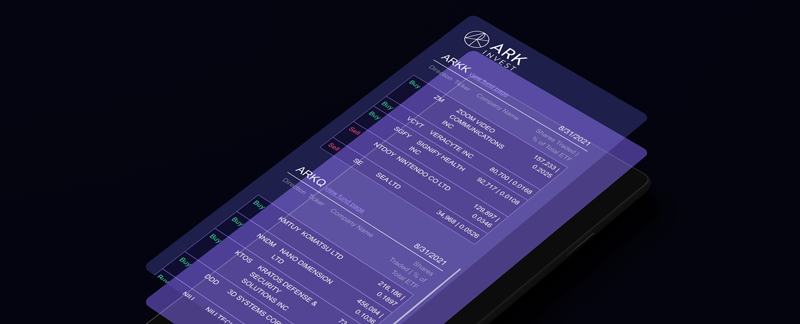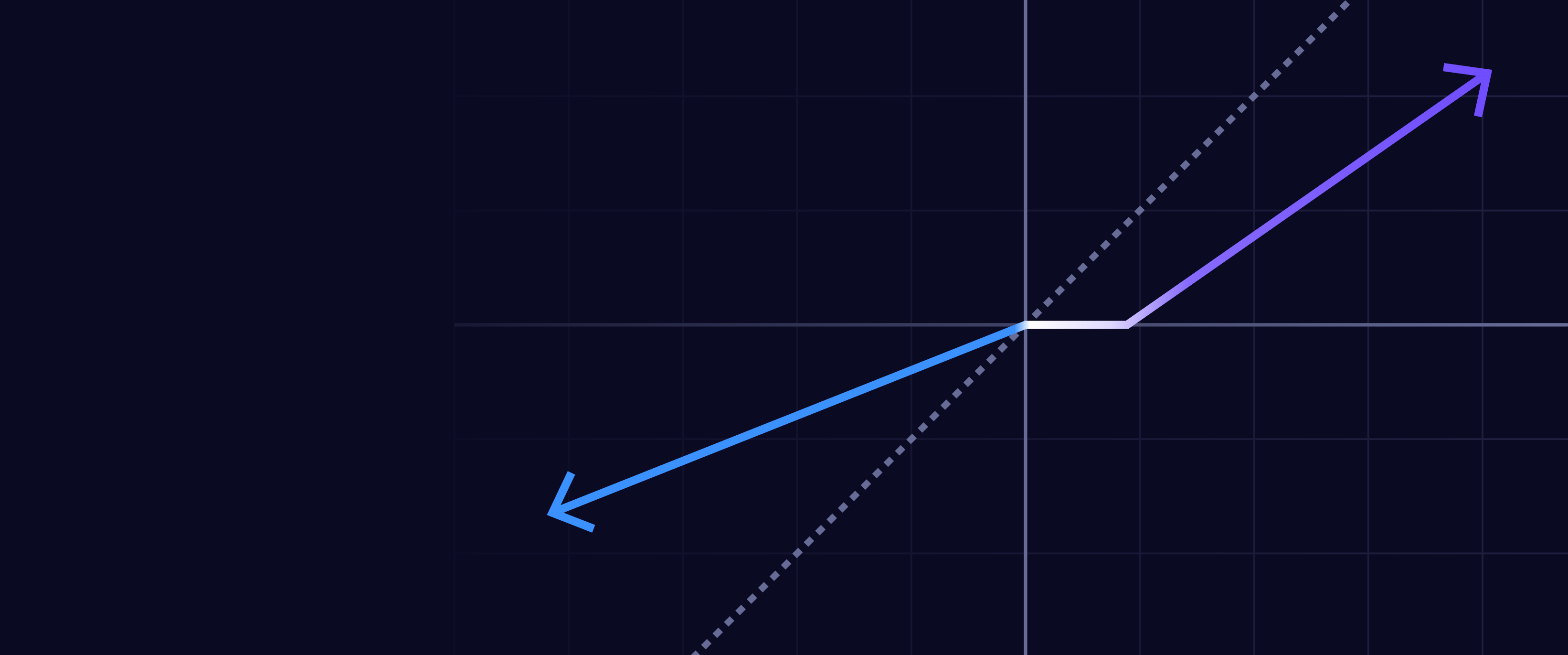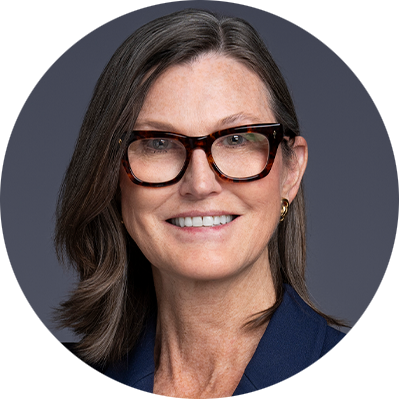Click here to download the PDF version.
Broad-based global equity indexes1 ended the quarter higher after rebounding from the sharp selloff triggered by threats of sweeping tariffs. In our view, the innovation space is not only recovering but also being revalued. The headwinds that once pressured disruptive technologies are shifting into structural tailwinds, supported by broadening market participation, favorable policy shifts around crypto, AI, and healthcare, and potential fiscal catalysts like tax cuts. Simultaneously, valuation premiums have normalized, with innovation assets now trading closer to market parity than historical norms. Should inflation continue to surprise on the low side of expectations, interest rates should follow, creating a constructive macroeconomic backdrop that will sustain momentum. The pro-growth policies of the Trump administration, as well as breakthroughs in AI, robotics, energy storage, blockchain, and multiomics, could drive a new cycle of productivity and long-term economic growth, particularly among underappreciated names not yet reflected in benchmark-heavy market leadership.
ARK’s research suggests that a rolling recession2 began in the spring of 2022, when the U.S. Federal Reserve (Fed) tightened monetary policy and raised interest rates by 22-fold in little more than a year. Our research also suggests that a loss of pricing power will force corporations to curb employment growth to protect margins. That said, the Five Innovation Platforms3 around which ARK has centered its research and investing could play an outsized role in pulling the economy out of the rolling recession, potentially salvaging corporate margins as inflation gives way to deflation in many sectors over the next few years. Supporting our perspective are the following indicators:
- Housing metrics like affordability and sales volumes continue to signal distress. Existing home sales remain depressed at 4.03 million units—down 37% from their 2022 peak and not far above levels seen during the global financial crisis, thanks in large part to the impact of mortgage rate lock-ins.4 The number of home sellers now exceeds buyers, creating the widest gap since Redfin began collecting data in 2013 and pointing to downward pressure on prices. After a weak spring selling season, new single family home inventories continued to increase in May. Compounding the risk, home price expectations remain elevated, a disconnect that may weigh on consumer spending and broader measures of household wealth.
- In the early days of the pandemic, autos accounted for roughly one-third of the inflation spike. Now, while used car prices remain elevated relative to historical norms, they have dropped 19% from their pandemic-era peak, signaling deflationary pressure in the sector.5 That said, auto sales surged above 17 million units (seasonally adjusted annual rate) in March and April—perhaps preemptive buying ahead of anticipated tariffs—before dropping below expectations to 15.3 million units in June.6
- As indicated by the PMI (Purchasing Managers Index), still below 50, manufacturing has been contracting since November 2022 and, despite the AI-related spending boom on data centers and power plants, capital spending as measured by non-defense capital goods excluding aircraft has begun to fall on a year-over-year basis.
- May was the first month since 2007 in which the ISM Services Prices Paid Index hit a two-year high while the New Orders index fell to a two-year low. This unusual divergence signals that rising input costs amid weakening demand is putting downward pressures on profit margins, often a harbinger of recessions that have prompted shifts in government policy.
- Small and medium businesses—the backbone of the US economy—have been reeling as measured by the NFIB (National Federation of Independent Business): in June 2022, their optimism dropped to levels last seen in 2008-09 and remained depressed until the election last November. After rebounding in hopes of deregulation, tax cuts, and lower interest rates, their optimism is relapsing now in response to tariffs and weaker economic activity.
- The consumer often is the last leg of a rolling recession. As measured by the University of Michigan, consumer confidence among high-income earners has capitulated, falling to the 2008-09 levels at which low- and middle-income earners have been mired since the Fed raised rates in 2022
- Signaling recession in July 2024, the employment report triggered the Sahm Rule, as the three-month moving average of the US unemployment rate rose 50 basis points7 above its lowest point in the last 12 months, historically an indicator that the economy has been in recession for three months. Underscoring labor market weakness, for the twelve months ended March 2024, the Bureau of Labor Statistics revised employment down by 818,000, the largest downward revision since 2009, taking the average growth in monthly payrolls down from 242,000 to 174,000 jobs per month. Although the Sahm Rule no longer is signaling outright recession, quit rates have dropped sharply since the post-COVID “Great Resignation” and are now down to 2.1%, just off their lowest level since the 2020 COVID lockdown, a signal that confidence in labor market opportunities is diminishing.
- The labor market remains fragile. WARN (Worker Adjustment and Retraining Notification) notices, a leading signal of future job cuts, are on the rise as major firms like P&G, Microsoft, and Intel announce layoffs. At the same time, continuing unemployment insurance claims are increasing while initial claims remain flat, suggesting that laid-off workers are struggling to find new employment as labor demand weakens.
While the Fed focused on raising interest rates to squelch inflation, the bond market was signaling deeper trouble, as the yield curve inverted from +159 basis points8 in March 2021 to -108 in July 2023—levels last seen in the early 1980s—only to reverse into a bear steepening phase in 2024, suggesting that both growth and inflation might undershoot expectations. Since supply shocks, geopolitical turmoil, inventory hoarding, and government spending spurred a year-over-year spike in inflation to 9.1% in 2022, consumer-based inflation as measured by the consumer price index (CPI) has dropped to 2.4%, aided by good, bad, and cyclical deflationary forces. Around the time the Fed paused rate hikes, ChatGPT highlighted the transformative innovation likely to turbocharge price deflation. During the next five to ten years, disruptive technologies—including robotics, energy storage, AI, blockchain, and multiomics sequencing—are likely to converge, creating powerful waves of both real growth and price deflation that we believe will reshape the macroeconomic landscape. Now that the cost to train and deploy AI has been falling more than 75% per year,9 the deflationary ramifications could intensify, reinforcing a macro regime characterized by innovation-led growth and structurally lower inflation.
While many economists are beginning to forecast a recession extending into 2026, our research suggests that the rolling recession that has been in place for the past three years should end with clarity on tariff, tax, regulatory, and monetary policies during the next three to six months. If the current tariff turmoil results in freer trade, as tariffs and non-tariff barriers come down in tandem with declines in other taxes, regulations, and interest rates, then real gross domestic product (GDP) growth and productivity could surprise on the high side of expectations at some point during the second half of this year.
Innovation tends to gain traction during tumultuous times: when consumers and businesses are concerned about the future, they are willing to change the way they do things. Inertia gives way to better, less expensive, faster, more productive, and more creative ways of living and working. During the current turbulent transition in the US, consumers and businesses are likely to accelerate the shift to technologically enabled innovation platforms including artificial intelligence, robotics, energy storage, blockchain technology, and multiomics sequencing.
During the second quarter of 2025, ARK's six actively managed ETFs outperformed the broad-based global equity indexes.
The ARK Autonomous Technology and Robotics ETF (ARKQ) outperformed broad-based global equity indices during the quarter. Among the top contributors were Kratos Defense & Security (KTOS) and AeroVironment (AVAV). Shares of Kratos Defense & Security Solutions contributed to performance amid a broad rally in defense stocks associated with President Trump’s executive order to boost the speed, flexibility, and execution in defense acquisitions. The company reported better-than-expected first-quarter earnings and completed a ~$575 million stock offering to fund national security-related capital expenditure. Shares of AeroVironment rallied on the same defense executive order. The company reported better-than-expected fiscal fourth-quarter earnings. International demand for its Switchblade Loitering Munitions Systems was particularly strong. Management also guided to an acceleration in organic revenue growth in fiscal year 2026, in addition to the revenue boost associated with the company's recent BlueHalo acquisition. Additionally, the company announced a ~$1.5 billion public offering to lower debt and scale manufacturing.
Among the top detractors were Aurora Innovation (AUR) and 3D Systems (DDD). Shares of Aurora Innovation detracted from performance, even though the company announced the launch of its commercial driverless trucking service in Texas. Sentiment was weighed down by Uber’s exchangeable senior note offering tied to ~36% of its stake in Aurora, the departure of co-founder Sterling Anderson, and a short report from Bleecker Street Research. Importantly, Uber’s transaction is non-dilutive, involving only existing shares. Later, Aurora disclosed that PACCAR requested a person in the autonomous truck’s driver’s seat because of prototype parts, which should not impact the company’s driverless development plans. Shares of 3D Systems traded down after the company reported weaker-than-expected first-quarter results amid a challenging capital spending environment. Citing macroeconomic uncertainties, management withdrew its full-year guidance while reaffirming its focus on profitability. Later in the quarter, the company issued a $92 million convertible note to retire existing debt and extend maturities to 2030. Given the prolonged headwinds facing industrial capital spending and uncertainty around scaling additive manufacturing investments, we exited our position in our actively managed funds.
The ARK Next Generation Internet ETF (ARKW) outperformed broad-based global equity indices during the quarter. Among the top contributors were Coinbase (COIN) and Robinhood (HOOD). Shares of Coinbase contributed to the fund’s performance, thanks to a series of strategic milestones that expanded its global footprint and diversified its revenue streams. The company secured a MiCA license from Luxembourg, granting it regulatory approval to offer crypto services across all EU member states. For $2.9 billion, Coinbase agreed to acquire Deribit, the world's largest crypto options exchange as measured by open interest. Additionally, JPMorgan selected Coinbase's Layer 2 network, Base, to support its USD deposit token, JPMD. The company also partnered with Shopify and Stripe to enable USDC stablecoin payments, facilitating faster and more secure transactions for merchants globally. These developments, coupled with Coinbase's 50% revenue share from Circle—whose IPO highlighted Coinbase's undervaluation— reinforced investor confidence and propelled stock performance. Shares of Robinhood appreciated after the company reported strong first-quarter earnings, including revenue growth of 50% year-over-year that beat Wall Street expectations. Robinhood also demonstrated exceptional product velocity, hosting a dedicated event focused on its crypto strategy. As part of its crypto push, Robinhood launched a promotion matching 2% of any crypto deposits on the platform. At its highly anticipated crypto event, the company introduced tokenized stocks and ETFs for EU customers, the launch of 24/5 commission-free trading of tokenized US securities, and the development of a proprietary Layer 2 blockchain built on Arbitrum to support tokenized assets. Additionally, Robinhood enabled crypto staking for Ethereum and Solana in the US, offering APYs (interest rates) higher than its competitors. The company also introduced advanced Robinhood Legend charts on its mobile app and added crypto rewards to its Robinhood Gold credit card.
Among the top detractors were PagerDuty (PD) and GitLab (GTLB). Shares of PagerDuty traded down after the company reported first-quarter fiscal 2026 results. Management lowered its forecast of full-year revenue, citing higher-than-expected downgrades to lower service levels among their large enterprise customers, as well as elevated churn in their commercial tier because of a reorganization of their go-to-market team. Shares of GitLab struggled after the company reported strong first-quarter earnings, including a significant upside revenue surprise, both of which were overshadowed by insider selling.
The ARK Genomic Revolution ETF (ARKG) outperformed broad-based global equity indices during the quarter. Among the top contributors were CRISPR Therapeutics (CRSP) and Tempus AI (TEM). Shares of CRISPR Therapeutics contributed to fund performance after the company reported positive Phase 1 results for its in vivo gene therapy, CTX310, which demonstrated encouraging reductions in LDL cholesterol and triglycerides. The company was also named one of TIME’s 100 Most Influential Companies, reflecting its growing impact on the field. Additionally, CRISPR Therapeutics announced a collaboration with Sirius Therapeutics to develop siRNA therapies, underscoring its continued strategic expansion opportunities and commitment to innovation. Shares of Tempus AI rallied following a series of strategic partnerships and the launch of new AI-driven tools aimed at enhancing oncology diagnostics and early disease detection. The company's collaboration with Northwestern University's Abrams Research Center to accelerate Alzheimer's research and the introduction of the Fuses program for personalized diagnostics added to investor interest.
Among the top detractors were Twist Bioscience (TWST) and Beam Therapeutics (BEAM). Shares of Twist Bioscience traded down after the company reported fiscal second-quarter earnings, including 23% revenue growth on a year-over-year basis. Impacting the stock negatively, the company announced that it is spinning out its DNA data storage division into Atlas Data Storage to focus on its core business. Shares of Beam Therapeutics declined despite encouraging clinical updates related to its alpha-1 antitrypsin deficiency (AATD) and sickle cell disease therapies. Additional data will be important to assess the long-term durability of Beam’s therapies. On a positive note, Beam received multiple regulatory breakthroughs, including Regenerative Medicine Advanced Therapy and Orphan Drug Designation for its AATD program, which could benefit its regulatory pathway.
The ARK Fintech Innovation ETF (ARKF) outperformed broad-based global equity indices during the quarter. Among the top contributors were Robinhood (HOOD) and Coinbase (COIN), for the reasons discussed above.
Among the top detractors were 3IQ Solana Staking ETF (SOLQ) and Kaspi (KSPI). Shares of the 3iQ Solana Staking ETF detracted from the fund’s performance as the price of Solana (SOL) stagnated, despite anticipation that the US Securities and Exchange Commission (SEC) will approve spot ETFs. Shares of Kaspi fell after the company reported first-quarter earnings, as management noted that macroeconomic headwinds like currency weakness and sharp interest rate hikes have increased deposit costs. Management also signaled caution around discretionary spending, which could impact GMV (Gross Merchandise Value) growth in the near term. Further, President Trump's reciprocal tariffs on Kazakhstan caused additional pressure.
The ARK Space Exploration & Innovation ETF (ARKX) outperformed broad-based global equity indices during the quarter. Among the top contributors were Rocket Lab (RKLB) and AeroVironment (AVAV), the latter for reasons discussed above. Shares of Rocket Lab rallied for several reasons. The US and the UK selected the company's hypersonic technologies for multi-billion-dollar defense contracts; Kratos selected Rocket Lab for a MACH-TB 2.0 test launch; and the European Space Agency selected it for its first dedicated satellite launch mission. The company also agreed to acquire Geost for $275 million, expanding it into EO/IR (Electro-Optical and Infrared) satellite payloads and reinforcing its role as an end-to-end national security space provider with exposure to the $175 billion Golden Dome initiative.
Among the top detractors were 3D Systems (DDD), for the reasons discussed above, and Garmin (GRMN). Shares of Garmin declined sharply early in the period amid heightened uncertainty caused by US tariff announcements and weaker-than-expected first-quarter margins and earnings.
Invested in the highest conviction names in the Funds discussed above, the ARK Innovation ETF (ARKK) outperformed broad-based global equity indices during the quarter. Among the top contributors were Coinbase (COIN), for the reasons discussed above, and Circle Internet Group (CRCL). Shares of Circle appreciated dramatically upon its initial public offering (IPO), buoyed by its position as the only publicly traded pure-play stablecoin issuer. Bolstering market sentiment were the launches of the Circle Payments Network (CPN) designed to modernize cross-border B2B transactions, and Circle Gateway that aggregates USDC positions across chains. These strategic developments, coupled with Circle’s deep integrations within the crypto ecosystem and its first-mover advantage in public markets, reinforced investor confidence and catalyzed strong performance.
Among the top detractors were PagerDuty (PD) and Beam Therapeutics (BEAM), for the reasons discussed above.
Among ARK’s self-indexed ETFs, the ARK Israel Innovation Technology ETF (IZRL) and The 3D Printing ETF (PRNT) outperformed the broad-based global equity indices.10
Shares of Pagaya Technologies (PGY) were the largest contributor to IZRL’s performance. The company raised its revenue outlook following strong first-quarter results, including guidance for 2025 and 2026 that implied double-digit growth. Pagaya’s successful diversification into auto- and point-of-sale lending and an expanding network of institutional funding partners boosted investor sentiment. Shares of Inmode (INMD) were the largest detractor from IZRL’s performance after the company reported a first-quarter revenue decline of 3% year-over-year, including a 10% decline in consumables and service revenues. The company is actively pursuing strategic mergers and acquisitions to enhance its injectables business and is restructuring its sales force. That said, ongoing sales declines in key products have led to negative investor sentiment.
Shares of FARO Technologies (FARO) were the largest contributor to PRNT’s performance following AMETEK’s agreement to acquire the company for $920 million in cash, subject to regulatory approvals. The transaction should close in the second half of 2025. Shares of 3D Systems (DDD) were the largest detractor from PRNT’s performance, for the reasons discussed above.
Broad-based global equity indexes are defined as the S&P 500 Index and the MSCI World Index.
A type of recession that affects different sectors of the economy at different times—not simultaneously.
ARK’s Five Innovation Platforms are Artificial Intelligence, Robotics, Energy Storage, Multiomic Sequencing, and Blockchain Technology.
National Associate of Realtors. Data as of May 2025.
Manheim Used Vehicle Value Index. Data as of June 2025.
WARD’s Automotive Group. Data of of June 2025.
A basis point (bp) is a unit of measurement used to quantify the change between two percentages. It is equal to 1/100th of 1%, or 0.01%.
A basis point (bp) is a unit of measurement used to quantify the change between two percentages. It is equal to 1/100th of 1%, or 0.01%.
ARK Investment Management LLC Big Ideas 2024.
IZRL underperformed its benchmark, ARK Israel Innovation Index. PRNT outperformed its benchmark, The Total 3-D Printing Index.
ARK’s statements are not an endorsement of any company or a recommendation to buy, sell or hold any security. ARK and its clients as well as its related persons may (but do not necessarily) have financial interests in securities or issuers that are discussed. Certain of the statements contained may be statements of future expectations and other forward-looking statements that are based on ARK’s current views and assumptions and involve known and unknown risks and uncertainties that could cause actual results, performance, or events to differ materially from those expressed or implied in such statements.
Explore ARK Funds
Featured Funds:

ARK Trade Notifications
ARK offers fully transparent Exchange Traded Funds (“ETFs”) and provides investors with trade information for all actively managed ETFs.








